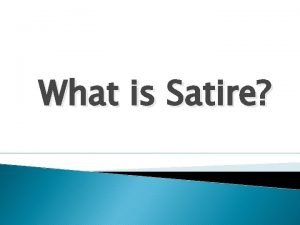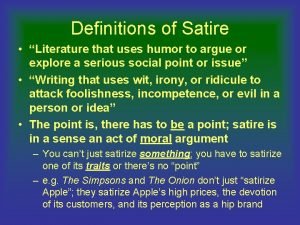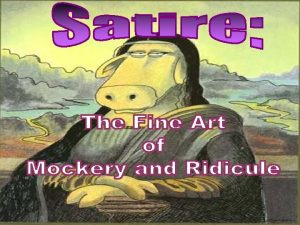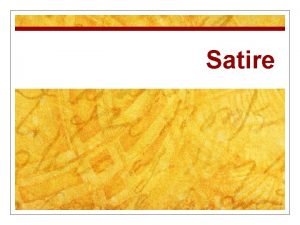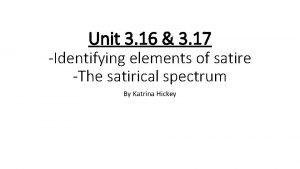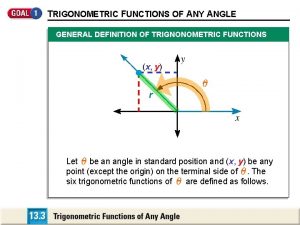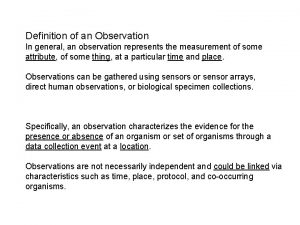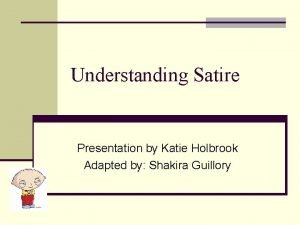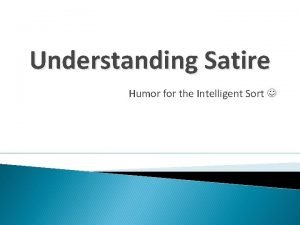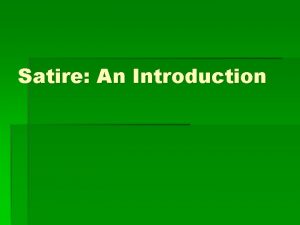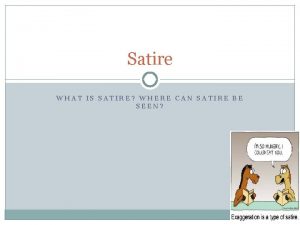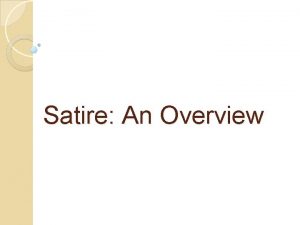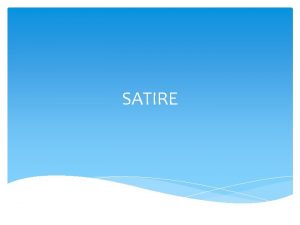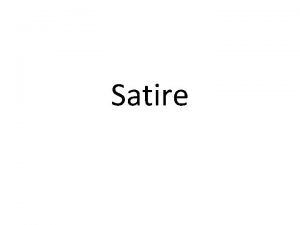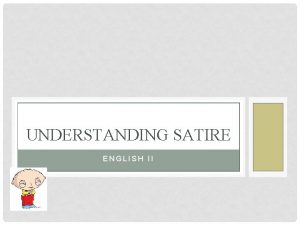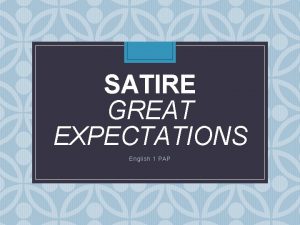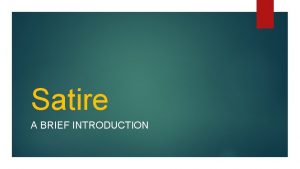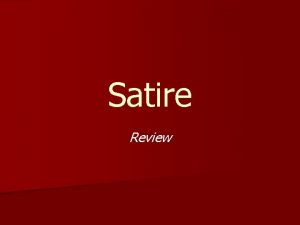Satire What is it General Definition n SATIRE

















- Slides: 17

Satire What is it?

General Definition: n SATIRE: any piece of writing designed to make its readers feel critical—of themselves, of their fellow human beings, of their society. n Some satire intends to make us laugh at human foolishness and weakness; others make us angry and indignant at human vices and crimes.

Definition Cont’d: n n n A key element of Satire is that it has a purpose—and that purpose is change. Satirists are critical or dissatisfied with things as they are, and they want to make them better. They are also aware, however, that most people don’t respond well to a lecture or direct criticism, so they employ a different tactic. n n Satirists make fun of selfish, mean-spirited, ignorant, or ridiculous people/policies in the hope that we will recognize the problem and make a change. They truly believed that through this method, people would look into the mirror they were holding up and realize their absurd, selfish, ridiculous behavior and make a change for the better.

Techniques: n n n EXAGGERATION: to enlarge, increase, or represent something beyond normal bounds so that it becomes ridiculous and its faults can be seen; every idea and concept is carried to the extreme, to capture the reader’s attention. No reasonable halfway measures are used-something is either all good or all bad. HYPERBOLE: wildly extravagant exaggeration UNDERSTATEMENT: the opposite of exaggeration

Techniques Cont’d: n IRONY: things are just the opposite of what they seem. Something small and trivial is made to seem important or serious; known as the “mountain out of a molehill” method. This can be reversed, as when something very important is made trivial, to show that people aren’t paying enough attention to this problem. In either case, the subject is described as the opposite of what really exists.

Techniques Cont’d: n n n INCONGRUITY: To present things that are out of place or are absurd in relation to its surroundings; INCONGRUOUS JUXTAPOSITION: placing side by side two things that do not belong together. REVERSAL: To present the opposite of the normal order (e. g. , the order of events, hierarchical order).

Techniques Cont’d: n PARODY: To imitate the techniques and/or style of some person, place, or thing.

Audience: n Satire can be directed at several kinds of TARGETS: n n n THE INDIVIDUAL -- the author makes fun of one person’s behavior and beliefs because he feels that the person is foolish or malicious. One example is Swift’s “The Death of the Late Famous General. ” THE GROUP -- the target can be a political party, a club, a social class, a profession, even a whole society. THE “SYSTEM” -- this often involves large systems of beliefs, such as religion, orhuman nature in general. One example is Swift’s “A Modest Proposal. ”

Modern Satire: n Although satire became a popular form during the Enlightenment (18 th century), it is flourishing today with: n n n Saturday Night Live South Park Family Guy The Daily Show The Colbert Report

Further Info on Technique: n Remember, also, the “Triumvirate of Persuasive Appeals” that any good argument should use: n n n Logical appeals: supporting a position with evidence, such as facts or statistics Emotional appeals: passages that use words that arouse strong feelings; Ethical appeals: passages that establish the writer as sincere and qualified to make the remarks.

Final Comments: “Honey and Medicine” n “The best satire does not seek to do harm or damage by its ridicule, unless we speak of damage to the structure of vice, but rather it seeks to create a shock of recognition and to make vice repulsive so that the vice will be expunged from the person or society under attack or from the person or society intended to benefit by the attack (regardless of who is the immediate object of attack); whenever possible this shock of recognition is to be conveyed through laughter or wit: the formula for satire is one of honey and medicine. Far from being simply destructive, satire is implicitly constructive, and the satirists themselves, whom I trust concerning such matters, often depict themselves as such constructive critics” (Harris).

“Honey and Medicine” Cont’d: n "Since social pressure seems to be one of the few forces to which fools and knaves will bow, the satirist can more effectively operate by enlisting the readers of the satire to aid him in bringing behavior back in line with publicized values. The satirist by himself is virtually impotent to change the vicious behavior of any particular target, for the satirist as himself is just another small, opinionated prude, and is easily dismissed by any remark that might pass for wit. The target must correct himself when he discovers he is under attack, or he must be driven to correct his behavior when hundreds of his peers join the satirist in ridiculing him or by ostracizing him from their society. . . ” (Harris)

How to Analyze Satire: Step 1 n The first step is to answer these three questions (using evidence to support): n n n What is the vice, folly, behavior that is being targeted? Who is the audience? (Individual? Group? Society? Be as specific as possible) What effect does the author hope to bring about by using satirical techniques?

Analyzing Satire, Step 2: How does the author satirize the subject? What techniques does the author use? n Consider both the “honey”, the way the author uses humor, wit, irony, exaggeration, etc. to make the audience laugh, and the “medicine”, the criticism of an individual, institution, or society- how does the author do it? n

Analyzing Satire: Step 3 n As a sort of conclusion, predict the probable effect of the satire on its audience and/or evaluate how effectively the author has used the techniques of satire to produce a needed change

Answer these questions: 1. 2. 3. 4. 5. What foolish, flawed, or wrong human action or aspect of society is being critiqued? How does the author mock/criticize the subject? (Techniques-choose 3 quotes to support your points) Who is the intended audience? What is the goal of the satirist? (What change is the satirist wishing for? ) How effective are the methods of the satirist?

Examples of Satire Use the 3 steps for analyzing satire to explain the purpose and technique of these 2 video clips: n http: //www. youtube. com/watch? v=XNBP 18 nr. Rdw n https: //www. youtube. com/watch? v=KFZz 6 I Czpj. I n
 Examples of exaggeration satire in shrek
Examples of exaggeration satire in shrek Diferencia entre gran plano general y plano general
Diferencia entre gran plano general y plano general Where did general lee surrender to general grant?
Where did general lee surrender to general grant? Techniques of satire
Techniques of satire Satire literary definition
Satire literary definition Satire definition literature
Satire definition literature Indirect satire definition
Indirect satire definition Satire definition literature
Satire definition literature Overstatement in a modest proposal
Overstatement in a modest proposal Examples of satire
Examples of satire General angle definition
General angle definition Family practice definition
Family practice definition Observation definition
Observation definition General duty clause definition
General duty clause definition General safety audit definition
General safety audit definition General appearance definition
General appearance definition Satirical techniques
Satirical techniques The three golden questions of satire are:
The three golden questions of satire are:



